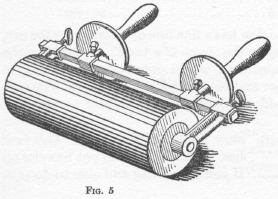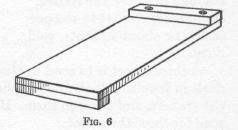A Woodcut Manual
 HE
theory of the art of woodcutting or wood-engraving is that, given a
smooth surfaced block, any scratch or groove made on it will show as
a white line on a black ground when the surface is inked and
impressed on a printable material. When the scratches and grooves are
made intelligently towards a predetermined and organized end, a
picture results.
HE
theory of the art of woodcutting or wood-engraving is that, given a
smooth surfaced block, any scratch or groove made on it will show as
a white line on a black ground when the surface is inked and
impressed on a printable material. When the scratches and grooves are
made intelligently towards a predetermined and organized end, a
picture results.
Engraving tools all ready for use may be had from E. C. Muller. The most useful in my estimation are:
Elliptic 85 cents
Round, No. 55 30 cents
Lozenge graver, No. 5 50 cents
Wilfred C. Kimber of London has a fine line of tools, ready for use. Uncle Sam stands in the way in the shape of a tariff. If you have the courage to brave the consequences I would suggest getting No. 4844 spit-sticker, No. 4846 scorper and No. 4841 lozenge graver. The cost is 1 shilling six pence, or about 40 cents, gold standard, per graver, plus postage and duty.
A third resort is to send to Henry Paulson & Company. This firm deals in jewellers' tools and supplies. You will have to put handles on the gravers, and sharpen them. If you are willing and able to do this, send for these three tools:
No. 2358, round .20 cents
No. 2385, anglet .20 cents
No. 2398, lozenge .30 cents
 No.
2353, a smaller radius graver, also priced at 20 cents, is not
absolutely necessary, but useful on occasion. No. 2676, handles for
the above, 10 cents each. Fig. 1 shows incisions made by these tools
in the order mentioned above, and Fig. 2, the
tools.
No.
2353, a smaller radius graver, also priced at 20 cents, is not
absolutely necessary, but useful on occasion. No. 2676, handles for
the above, 10 cents each. Fig. 1 shows incisions made by these tools
in the order mentioned above, and Fig. 2, the
tools.
 Send
$1.00 to J. Johnson & Co. for end-grain maple blocks to that
value, in sizes about 2 x 3 and 3 x 4 inches. The blocks come type
high and ready for engraving at two cents per square inch, plus
postage. Note direction of the grain of block in Fig. 3. Maple is a
cheap substitute for box wood.
Send
$1.00 to J. Johnson & Co. for end-grain maple blocks to that
value, in sizes about 2 x 3 and 3 x 4 inches. The blocks come type
high and ready for engraving at two cents per square inch, plus
postage. Note direction of the grain of block in Fig. 3. Maple is a
cheap substitute for box wood.
 Write
to the nearest branch of the American Type Founders Company - the
main office will send the address, or any printer will furnish it -
and get a six-inch brayer. It is also called an inking roller. See
Fig. 4. If it is planned to make larger designs than six inches in
width, it will be better to get a wider roller - preferably a
twelve-inch one. See Fig. 5. Also, get a tube of black ink suitable
for woodcut printing. It may be had from Frederick Levey & Co. or
at any printers supply house for one dollar. A dollar can will
contain twice as much as the tube. However there is likely to be
considerable spoilage and bother with half-dried lumps and skins.
Water may be put into the can to keep air from the ink.
Write
to the nearest branch of the American Type Founders Company - the
main office will send the address, or any printer will furnish it -
and get a six-inch brayer. It is also called an inking roller. See
Fig. 4. If it is planned to make larger designs than six inches in
width, it will be better to get a wider roller - preferably a
twelve-inch one. See Fig. 5. Also, get a tube of black ink suitable
for woodcut printing. It may be had from Frederick Levey & Co. or
at any printers supply house for one dollar. A dollar can will
contain twice as much as the tube. However there is likely to be
considerable spoilage and bother with half-dried lumps and skins.
Water may be put into the can to keep air from the ink.
 Oil
stones for sharpening gravers may be had cheapest from mail order
houses. Hardware dealers carrying carpenter's tools would have them
in stock. Arkansas are best. One about 4 x 2 will be all right. Use
kerosene oil on it as a lubricant.
Oil
stones for sharpening gravers may be had cheapest from mail order
houses. Hardware dealers carrying carpenter's tools would have them
in stock. Arkansas are best. One about 4 x 2 will be all right. Use
kerosene oil on it as a lubricant.
For a starter, any thin, soft and tough paper may be used for printing. The best for the beginner is the Japanese. The Japan Paper Co. will send an assortment for $1.30.
The drawing on the block can be in pencil, which rubs off; it may better be strengthened with ink. Water-proof ink is not imperative.
A pound of oxide of zinc, also called powdered zinc and zinc white, will last a long time and costs very little. It may be had from paint dealers.
 A small
box about four inches high will be good enough to start with as a
rest for the block while engraving, or a number of books that height.
Any congressman will take it as an important duty to supply bound
copies of congressional reports. As books I cannot imagine what else
they could be good for. I find that a bench hook is a useful article.
See Fig. 6. This is simply a board about eight inches in width and
about ten inches long, with a cleat on each end and opposite sides.
The lower cleat is to rest against the table edge; the woodblock
bears against the upper one. These cleats ought to be screwed on and
countersunk so that a slip of the graver will not result in its
damage against the screw head.
A small
box about four inches high will be good enough to start with as a
rest for the block while engraving, or a number of books that height.
Any congressman will take it as an important duty to supply bound
copies of congressional reports. As books I cannot imagine what else
they could be good for. I find that a bench hook is a useful article.
See Fig. 6. This is simply a board about eight inches in width and
about ten inches long, with a cleat on each end and opposite sides.
The lower cleat is to rest against the table edge; the woodblock
bears against the upper one. These cleats ought to be screwed on and
countersunk so that a slip of the graver will not result in its
damage against the screw head.
 The names used
for the tools are as given by the dealers or manufacturers.
Technically, the elliptic, anglet (No. 2385) and No. 4844 are known
as spit-stickers. They are used chiefly for making curved lines. The
round graver No. 55, No. 2358, and No. 4846 are called scorpers, used
chiefly for cutting the wider lines and areas and for cleaning up
generally. The lozenge shape No. 5, No. 2398 and No. 4841 are the
true gravers used for general work. The word graver will be used in
its generic sense in this book.
The names used
for the tools are as given by the dealers or manufacturers.
Technically, the elliptic, anglet (No. 2385) and No. 4844 are known
as spit-stickers. They are used chiefly for making curved lines. The
round graver No. 55, No. 2358, and No. 4846 are called scorpers, used
chiefly for cutting the wider lines and areas and for cleaning up
generally. The lozenge shape No. 5, No. 2398 and No. 4841 are the
true gravers used for general work. The word graver will be used in
its generic sense in this book.